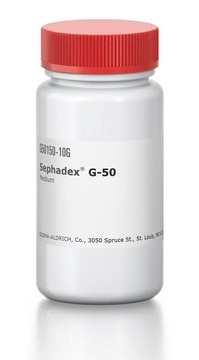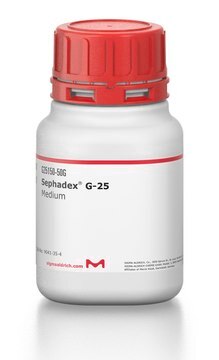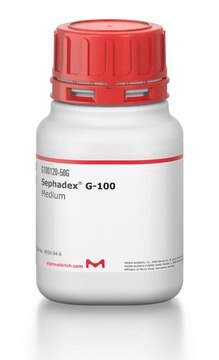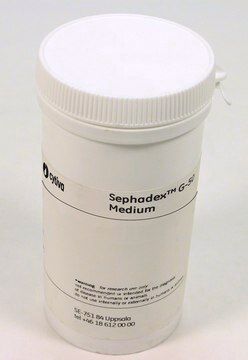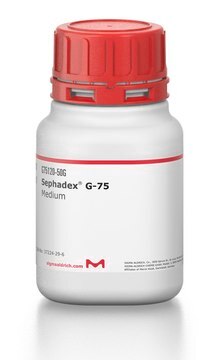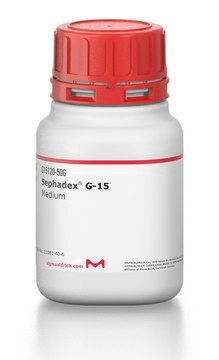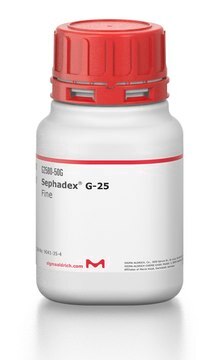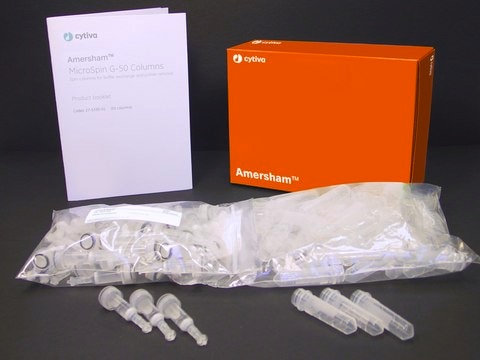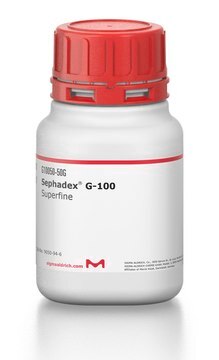G5080
Sephadex® G-50
Fine
Synonym(e):
Gel filtration resin, Sephadex G-50 Fine Medium
About This Item
Empfohlene Produkte
Qualitätsniveau
Methode(n)
affinity chromatography: suitable
Aktive Matrixgruppe
phase
Quellen
1 g swells to 9-11 mL
Perlengröße
20-80 μm
Anwendung(en)
life science and biopharma
Kompatibilität
Cytiva
Verwandte Kategorien
Allgemeine Beschreibung
Fractionation Range (MW)
Globular Proteins: 1,500 - 30,000
Dextrans: 500 - 10,000
Anwendung
- to remove the non-entrapped carboxyfluorescein (CF) from the liposome suspension
- in the purification of monoclonal antibody (mAb) humanized MN-14 by centrifuged size-exclusion chromatography
- in desalting the recombinant enzymes eluted in the fraction five and six
- the separation of low and high molecular weight molecules
- affinity chromatography, protein chromatography, and gel filtration chromatography
Leistungsmerkmale und Vorteile
- Desalts, removes contaminants, and transfers to a new buffer in one step.
- Suitable for DNA purification from small molecules using gel filtration.
- Features a small bead size, resulting in shorter diffusion distances.
- Considered a classic gel filtration resin.
- Desalting with Sephadex is considered superior to dialysis because it saves time, has a low dilution factor, and recovers high activity even with minute amounts of sample
Sonstige Hinweise
G5080-500G′s updated product number is GE17-0042-02
Rechtliche Hinweise
Ersetzt durch
Lagerklassenschlüssel
11 - Combustible Solids
WGK
WGK 3
Flammpunkt (°F)
Not applicable
Flammpunkt (°C)
Not applicable
Persönliche Schutzausrüstung
Eyeshields, Gloves, type N95 (US)
Analysenzertifikate (COA)
Suchen Sie nach Analysenzertifikate (COA), indem Sie die Lot-/Chargennummer des Produkts eingeben. Lot- und Chargennummern sind auf dem Produktetikett hinter den Wörtern ‘Lot’ oder ‘Batch’ (Lot oder Charge) zu finden.
Besitzen Sie dieses Produkt bereits?
In der Dokumentenbibliothek finden Sie die Dokumentation zu den Produkten, die Sie kürzlich erworben haben.
Kunden haben sich ebenfalls angesehen
Unser Team von Wissenschaftlern verfügt über Erfahrung in allen Forschungsbereichen einschließlich Life Science, Materialwissenschaften, chemischer Synthese, Chromatographie, Analytik und vielen mehr..
Setzen Sie sich mit dem technischen Dienst in Verbindung.